Strategic Risk Management: Theoretical Approaches and Implementation
VerifiedAdded on 2022/10/02
|15
|4250
|51
Report
AI Summary
This report provides a comprehensive overview of strategic risk management, focusing on theoretical approaches and their practical application within organizational settings. It begins by defining strategic risk management and its importance, highlighting the role of the board of directors and the identification of potential risks. The report then delves into three key theories: Protection Motivation Theory, Risk Compensation Theory, and Social Action Theory, explaining their principles and relevance to risk perception and management. Furthermore, the report explores the interdisciplinary nature of risk, emphasizing its complexity and the importance of effective management. The role of effective risk management is discussed, including principles, standards, and the integration of risk management into organizational decision-making. The report also touches on the management of foreign currency and reputation risks, providing a holistic view of risk management practices.
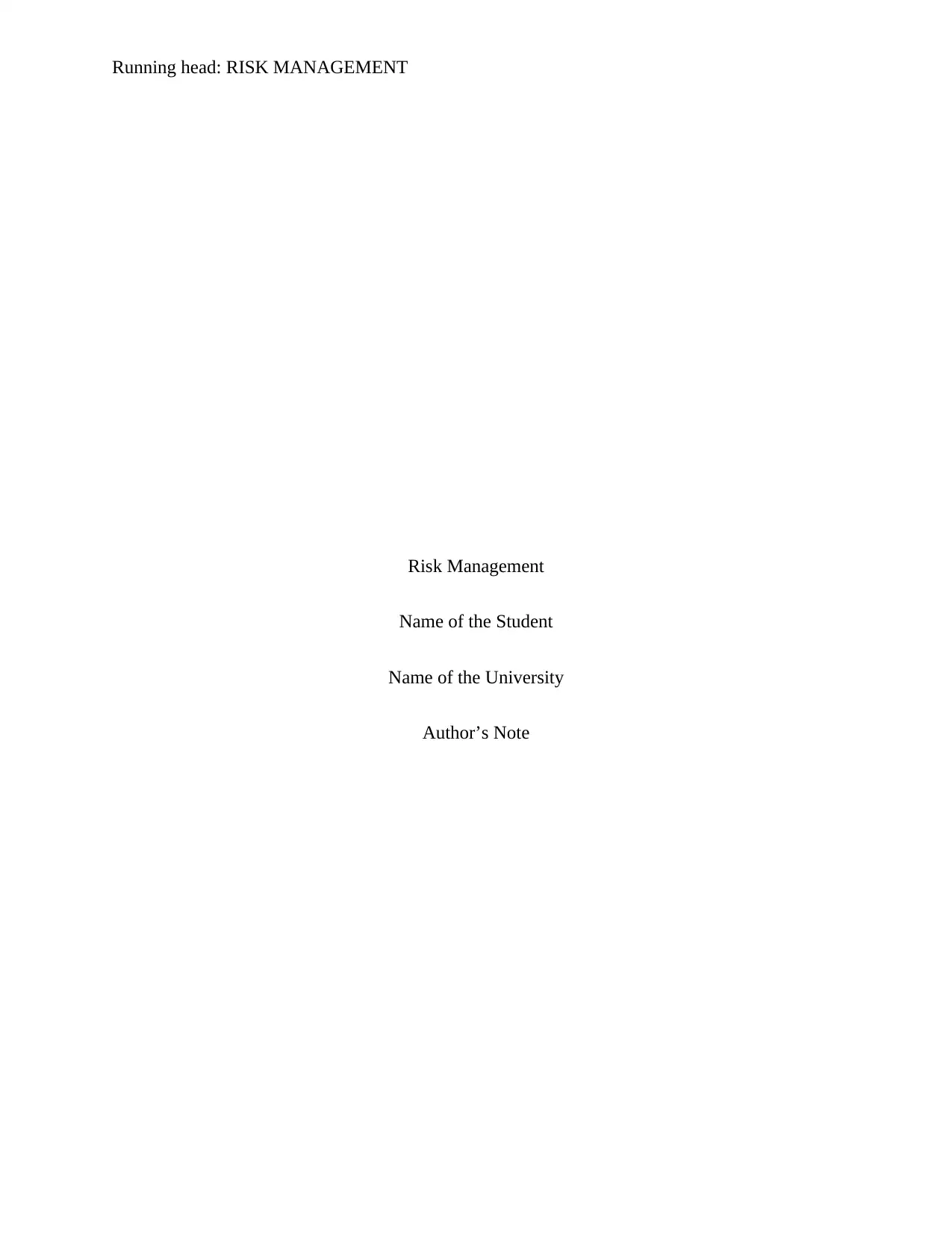
Running head: RISK MANAGEMENT
Risk Management
Name of the Student
Name of the University
Author’s Note
Risk Management
Name of the Student
Name of the University
Author’s Note
Paraphrase This Document
Need a fresh take? Get an instant paraphrase of this document with our AI Paraphraser
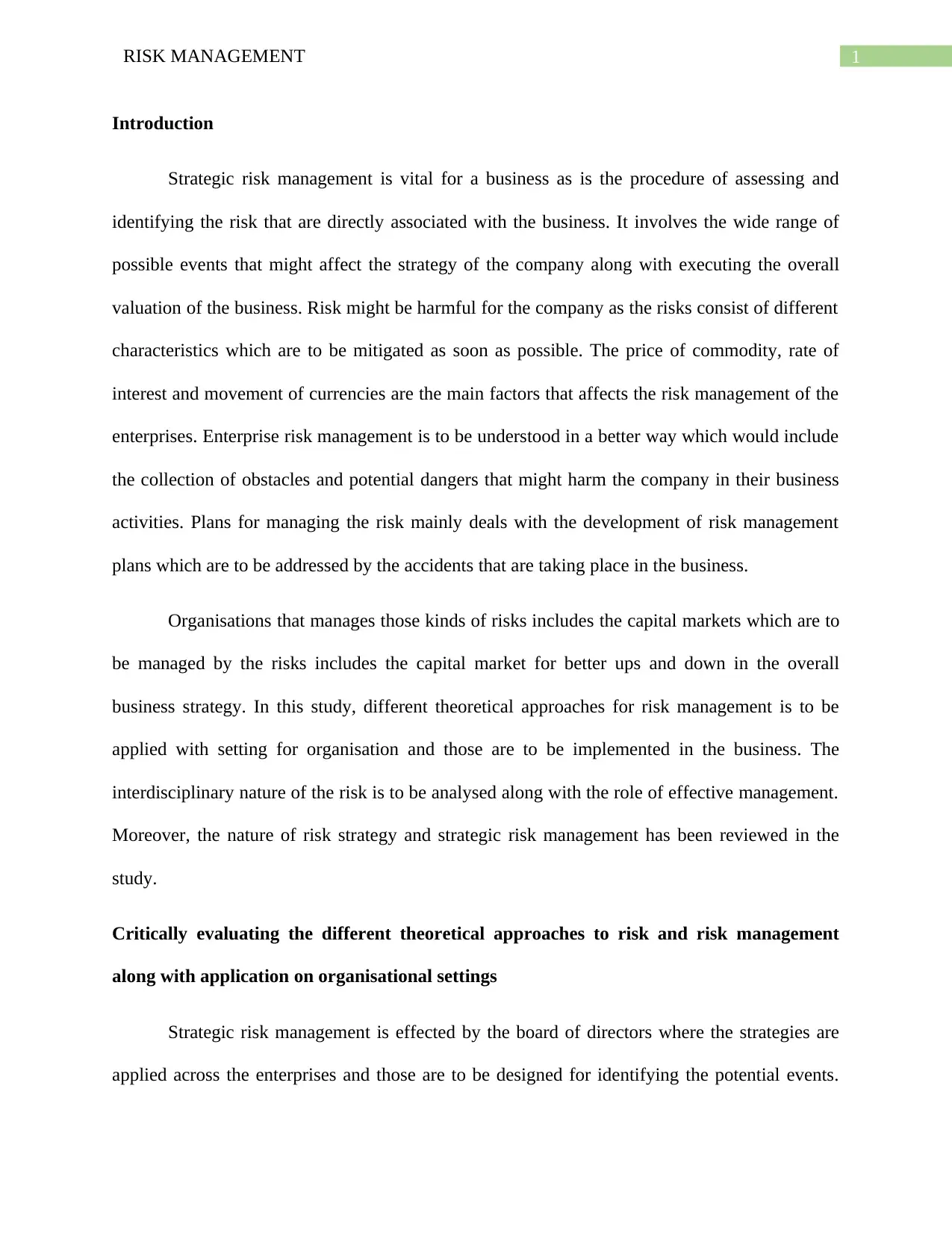
1RISK MANAGEMENT
Introduction
Strategic risk management is vital for a business as is the procedure of assessing and
identifying the risk that are directly associated with the business. It involves the wide range of
possible events that might affect the strategy of the company along with executing the overall
valuation of the business. Risk might be harmful for the company as the risks consist of different
characteristics which are to be mitigated as soon as possible. The price of commodity, rate of
interest and movement of currencies are the main factors that affects the risk management of the
enterprises. Enterprise risk management is to be understood in a better way which would include
the collection of obstacles and potential dangers that might harm the company in their business
activities. Plans for managing the risk mainly deals with the development of risk management
plans which are to be addressed by the accidents that are taking place in the business.
Organisations that manages those kinds of risks includes the capital markets which are to
be managed by the risks includes the capital market for better ups and down in the overall
business strategy. In this study, different theoretical approaches for risk management is to be
applied with setting for organisation and those are to be implemented in the business. The
interdisciplinary nature of the risk is to be analysed along with the role of effective management.
Moreover, the nature of risk strategy and strategic risk management has been reviewed in the
study.
Critically evaluating the different theoretical approaches to risk and risk management
along with application on organisational settings
Strategic risk management is effected by the board of directors where the strategies are
applied across the enterprises and those are to be designed for identifying the potential events.
Introduction
Strategic risk management is vital for a business as is the procedure of assessing and
identifying the risk that are directly associated with the business. It involves the wide range of
possible events that might affect the strategy of the company along with executing the overall
valuation of the business. Risk might be harmful for the company as the risks consist of different
characteristics which are to be mitigated as soon as possible. The price of commodity, rate of
interest and movement of currencies are the main factors that affects the risk management of the
enterprises. Enterprise risk management is to be understood in a better way which would include
the collection of obstacles and potential dangers that might harm the company in their business
activities. Plans for managing the risk mainly deals with the development of risk management
plans which are to be addressed by the accidents that are taking place in the business.
Organisations that manages those kinds of risks includes the capital markets which are to
be managed by the risks includes the capital market for better ups and down in the overall
business strategy. In this study, different theoretical approaches for risk management is to be
applied with setting for organisation and those are to be implemented in the business. The
interdisciplinary nature of the risk is to be analysed along with the role of effective management.
Moreover, the nature of risk strategy and strategic risk management has been reviewed in the
study.
Critically evaluating the different theoretical approaches to risk and risk management
along with application on organisational settings
Strategic risk management is effected by the board of directors where the strategies are
applied across the enterprises and those are to be designed for identifying the potential events.
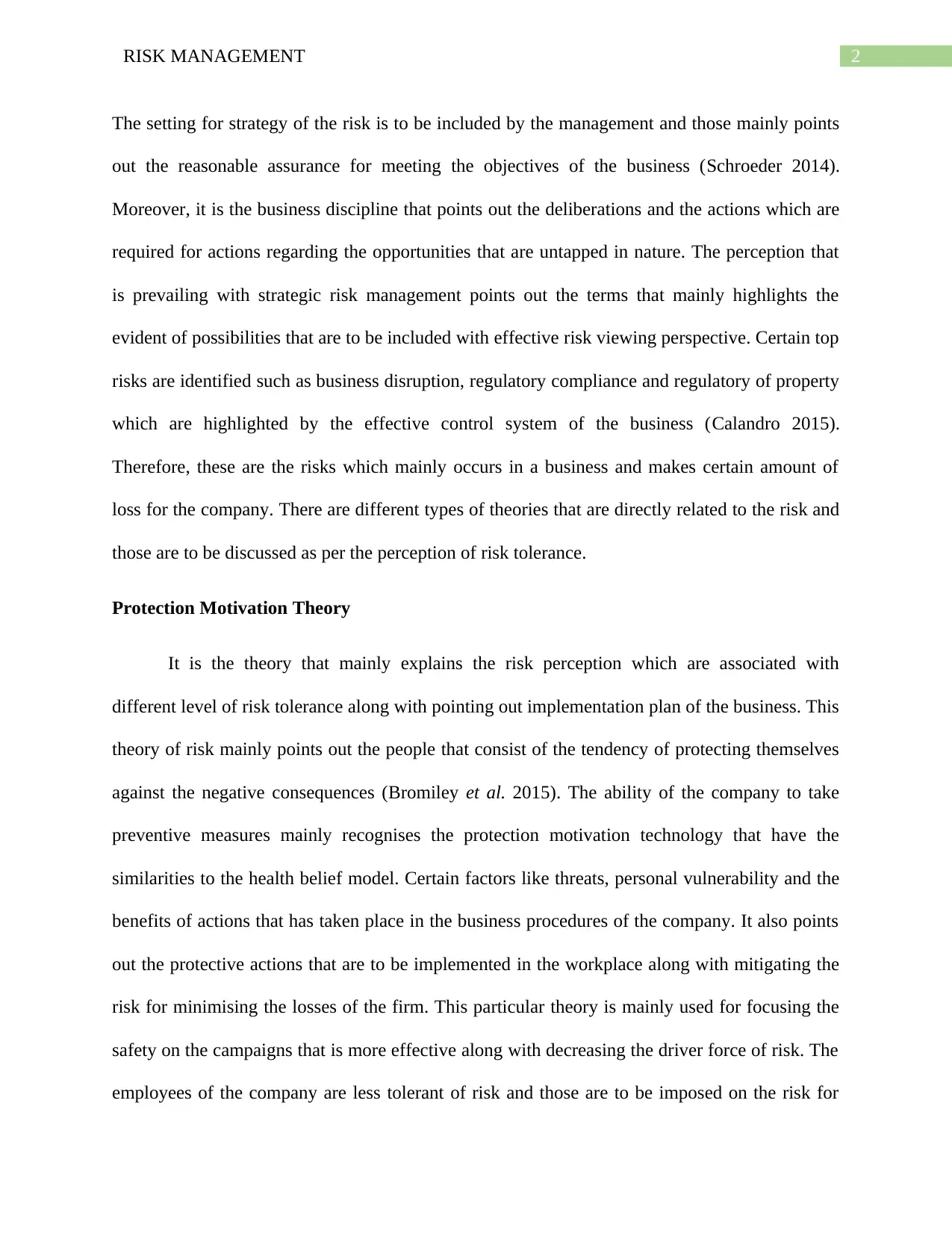
2RISK MANAGEMENT
The setting for strategy of the risk is to be included by the management and those mainly points
out the reasonable assurance for meeting the objectives of the business (Schroeder 2014).
Moreover, it is the business discipline that points out the deliberations and the actions which are
required for actions regarding the opportunities that are untapped in nature. The perception that
is prevailing with strategic risk management points out the terms that mainly highlights the
evident of possibilities that are to be included with effective risk viewing perspective. Certain top
risks are identified such as business disruption, regulatory compliance and regulatory of property
which are highlighted by the effective control system of the business (Calandro 2015).
Therefore, these are the risks which mainly occurs in a business and makes certain amount of
loss for the company. There are different types of theories that are directly related to the risk and
those are to be discussed as per the perception of risk tolerance.
Protection Motivation Theory
It is the theory that mainly explains the risk perception which are associated with
different level of risk tolerance along with pointing out implementation plan of the business. This
theory of risk mainly points out the people that consist of the tendency of protecting themselves
against the negative consequences (Bromiley et al. 2015). The ability of the company to take
preventive measures mainly recognises the protection motivation technology that have the
similarities to the health belief model. Certain factors like threats, personal vulnerability and the
benefits of actions that has taken place in the business procedures of the company. It also points
out the protective actions that are to be implemented in the workplace along with mitigating the
risk for minimising the losses of the firm. This particular theory is mainly used for focusing the
safety on the campaigns that is more effective along with decreasing the driver force of risk. The
employees of the company are less tolerant of risk and those are to be imposed on the risk for
The setting for strategy of the risk is to be included by the management and those mainly points
out the reasonable assurance for meeting the objectives of the business (Schroeder 2014).
Moreover, it is the business discipline that points out the deliberations and the actions which are
required for actions regarding the opportunities that are untapped in nature. The perception that
is prevailing with strategic risk management points out the terms that mainly highlights the
evident of possibilities that are to be included with effective risk viewing perspective. Certain top
risks are identified such as business disruption, regulatory compliance and regulatory of property
which are highlighted by the effective control system of the business (Calandro 2015).
Therefore, these are the risks which mainly occurs in a business and makes certain amount of
loss for the company. There are different types of theories that are directly related to the risk and
those are to be discussed as per the perception of risk tolerance.
Protection Motivation Theory
It is the theory that mainly explains the risk perception which are associated with
different level of risk tolerance along with pointing out implementation plan of the business. This
theory of risk mainly points out the people that consist of the tendency of protecting themselves
against the negative consequences (Bromiley et al. 2015). The ability of the company to take
preventive measures mainly recognises the protection motivation technology that have the
similarities to the health belief model. Certain factors like threats, personal vulnerability and the
benefits of actions that has taken place in the business procedures of the company. It also points
out the protective actions that are to be implemented in the workplace along with mitigating the
risk for minimising the losses of the firm. This particular theory is mainly used for focusing the
safety on the campaigns that is more effective along with decreasing the driver force of risk. The
employees of the company are less tolerant of risk and those are to be imposed on the risk for
⊘ This is a preview!⊘
Do you want full access?
Subscribe today to unlock all pages.

Trusted by 1+ million students worldwide
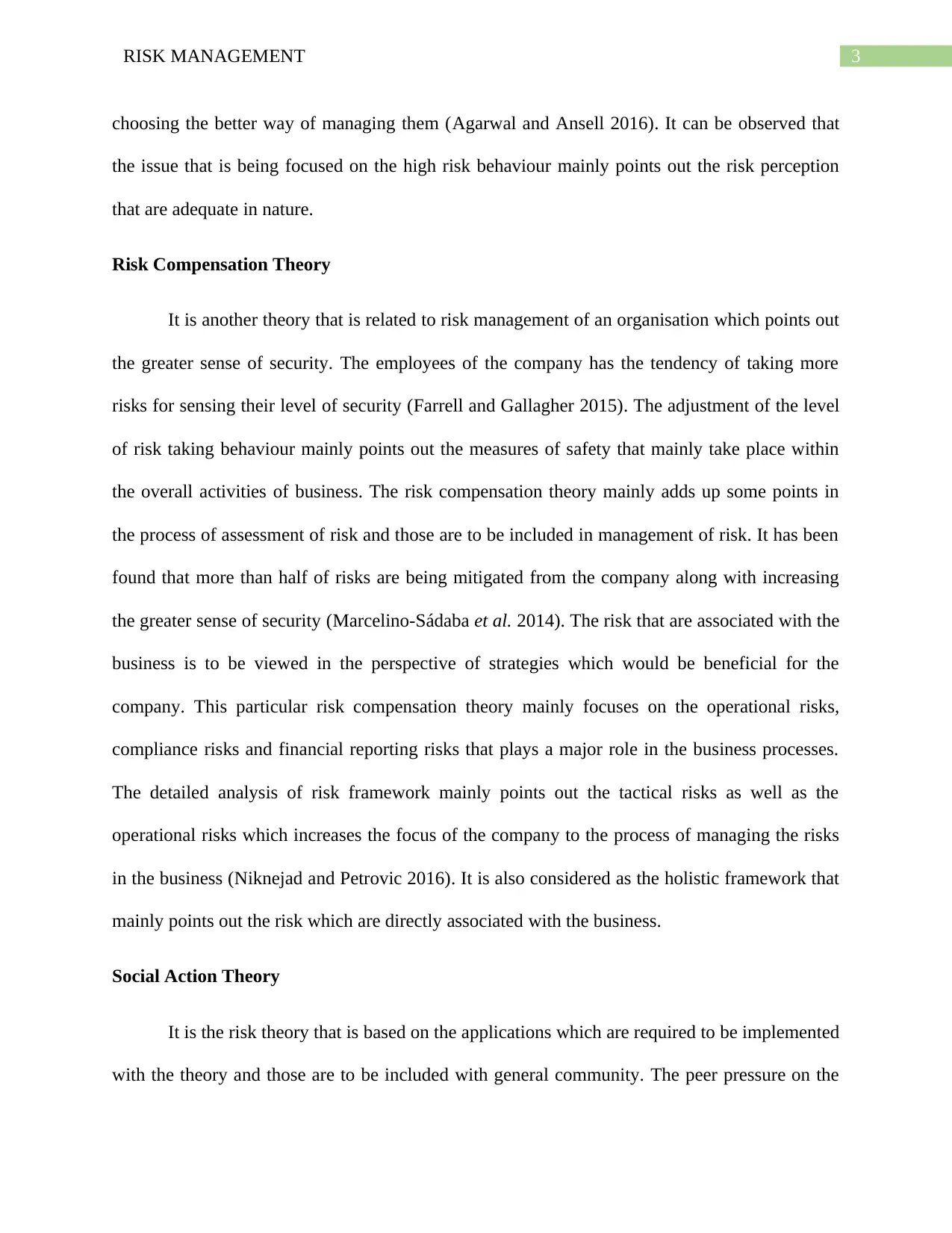
3RISK MANAGEMENT
choosing the better way of managing them (Agarwal and Ansell 2016). It can be observed that
the issue that is being focused on the high risk behaviour mainly points out the risk perception
that are adequate in nature.
Risk Compensation Theory
It is another theory that is related to risk management of an organisation which points out
the greater sense of security. The employees of the company has the tendency of taking more
risks for sensing their level of security (Farrell and Gallagher 2015). The adjustment of the level
of risk taking behaviour mainly points out the measures of safety that mainly take place within
the overall activities of business. The risk compensation theory mainly adds up some points in
the process of assessment of risk and those are to be included in management of risk. It has been
found that more than half of risks are being mitigated from the company along with increasing
the greater sense of security (Marcelino-Sádaba et al. 2014). The risk that are associated with the
business is to be viewed in the perspective of strategies which would be beneficial for the
company. This particular risk compensation theory mainly focuses on the operational risks,
compliance risks and financial reporting risks that plays a major role in the business processes.
The detailed analysis of risk framework mainly points out the tactical risks as well as the
operational risks which increases the focus of the company to the process of managing the risks
in the business (Niknejad and Petrovic 2016). It is also considered as the holistic framework that
mainly points out the risk which are directly associated with the business.
Social Action Theory
It is the risk theory that is based on the applications which are required to be implemented
with the theory and those are to be included with general community. The peer pressure on the
choosing the better way of managing them (Agarwal and Ansell 2016). It can be observed that
the issue that is being focused on the high risk behaviour mainly points out the risk perception
that are adequate in nature.
Risk Compensation Theory
It is another theory that is related to risk management of an organisation which points out
the greater sense of security. The employees of the company has the tendency of taking more
risks for sensing their level of security (Farrell and Gallagher 2015). The adjustment of the level
of risk taking behaviour mainly points out the measures of safety that mainly take place within
the overall activities of business. The risk compensation theory mainly adds up some points in
the process of assessment of risk and those are to be included in management of risk. It has been
found that more than half of risks are being mitigated from the company along with increasing
the greater sense of security (Marcelino-Sádaba et al. 2014). The risk that are associated with the
business is to be viewed in the perspective of strategies which would be beneficial for the
company. This particular risk compensation theory mainly focuses on the operational risks,
compliance risks and financial reporting risks that plays a major role in the business processes.
The detailed analysis of risk framework mainly points out the tactical risks as well as the
operational risks which increases the focus of the company to the process of managing the risks
in the business (Niknejad and Petrovic 2016). It is also considered as the holistic framework that
mainly points out the risk which are directly associated with the business.
Social Action Theory
It is the risk theory that is based on the applications which are required to be implemented
with the theory and those are to be included with general community. The peer pressure on the
Paraphrase This Document
Need a fresh take? Get an instant paraphrase of this document with our AI Paraphraser
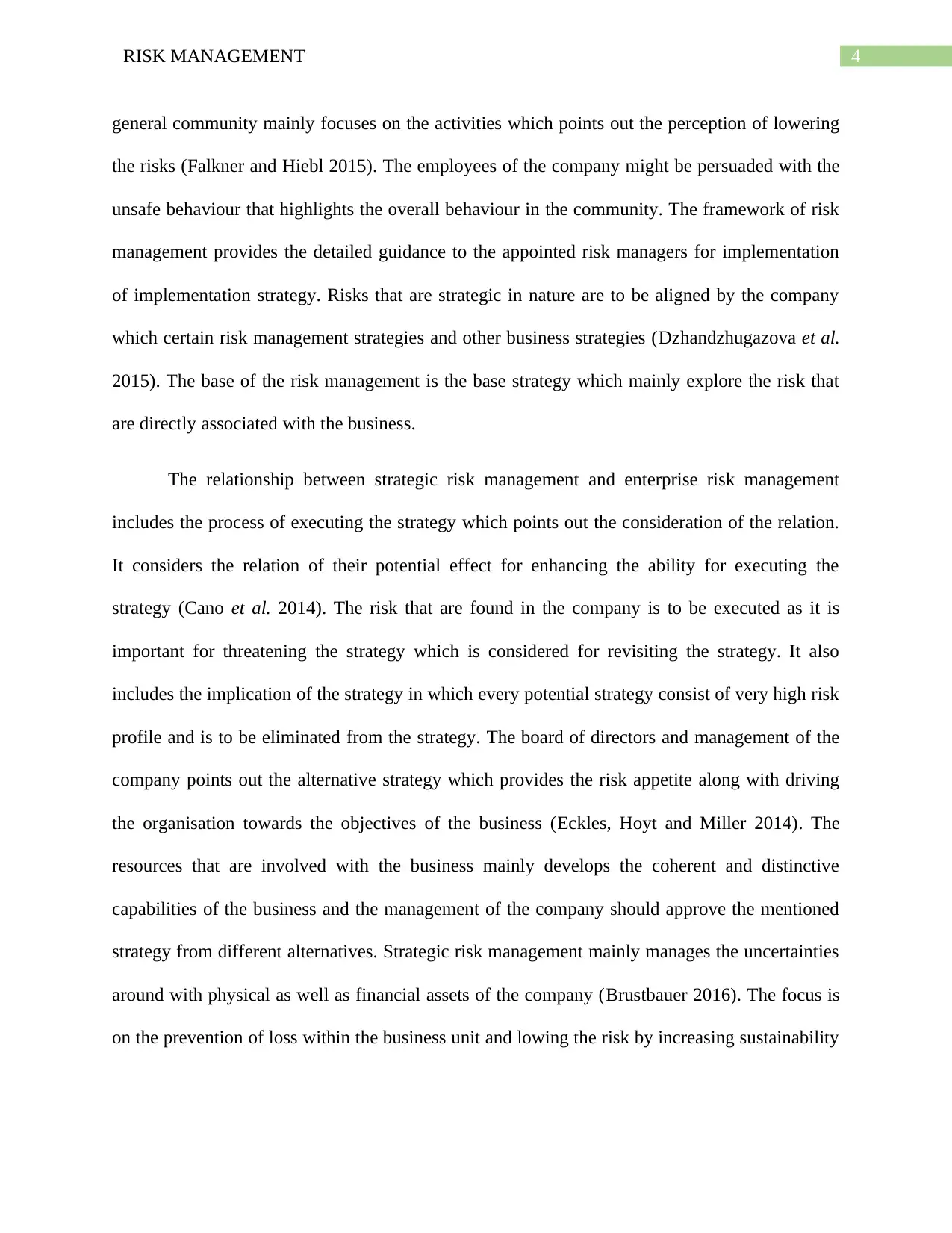
4RISK MANAGEMENT
general community mainly focuses on the activities which points out the perception of lowering
the risks (Falkner and Hiebl 2015). The employees of the company might be persuaded with the
unsafe behaviour that highlights the overall behaviour in the community. The framework of risk
management provides the detailed guidance to the appointed risk managers for implementation
of implementation strategy. Risks that are strategic in nature are to be aligned by the company
which certain risk management strategies and other business strategies (Dzhandzhugazova et al.
2015). The base of the risk management is the base strategy which mainly explore the risk that
are directly associated with the business.
The relationship between strategic risk management and enterprise risk management
includes the process of executing the strategy which points out the consideration of the relation.
It considers the relation of their potential effect for enhancing the ability for executing the
strategy (Cano et al. 2014). The risk that are found in the company is to be executed as it is
important for threatening the strategy which is considered for revisiting the strategy. It also
includes the implication of the strategy in which every potential strategy consist of very high risk
profile and is to be eliminated from the strategy. The board of directors and management of the
company points out the alternative strategy which provides the risk appetite along with driving
the organisation towards the objectives of the business (Eckles, Hoyt and Miller 2014). The
resources that are involved with the business mainly develops the coherent and distinctive
capabilities of the business and the management of the company should approve the mentioned
strategy from different alternatives. Strategic risk management mainly manages the uncertainties
around with physical as well as financial assets of the company (Brustbauer 2016). The focus is
on the prevention of loss within the business unit and lowing the risk by increasing sustainability
general community mainly focuses on the activities which points out the perception of lowering
the risks (Falkner and Hiebl 2015). The employees of the company might be persuaded with the
unsafe behaviour that highlights the overall behaviour in the community. The framework of risk
management provides the detailed guidance to the appointed risk managers for implementation
of implementation strategy. Risks that are strategic in nature are to be aligned by the company
which certain risk management strategies and other business strategies (Dzhandzhugazova et al.
2015). The base of the risk management is the base strategy which mainly explore the risk that
are directly associated with the business.
The relationship between strategic risk management and enterprise risk management
includes the process of executing the strategy which points out the consideration of the relation.
It considers the relation of their potential effect for enhancing the ability for executing the
strategy (Cano et al. 2014). The risk that are found in the company is to be executed as it is
important for threatening the strategy which is considered for revisiting the strategy. It also
includes the implication of the strategy in which every potential strategy consist of very high risk
profile and is to be eliminated from the strategy. The board of directors and management of the
company points out the alternative strategy which provides the risk appetite along with driving
the organisation towards the objectives of the business (Eckles, Hoyt and Miller 2014). The
resources that are involved with the business mainly develops the coherent and distinctive
capabilities of the business and the management of the company should approve the mentioned
strategy from different alternatives. Strategic risk management mainly manages the uncertainties
around with physical as well as financial assets of the company (Brustbauer 2016). The focus is
on the prevention of loss within the business unit and lowing the risk by increasing sustainability
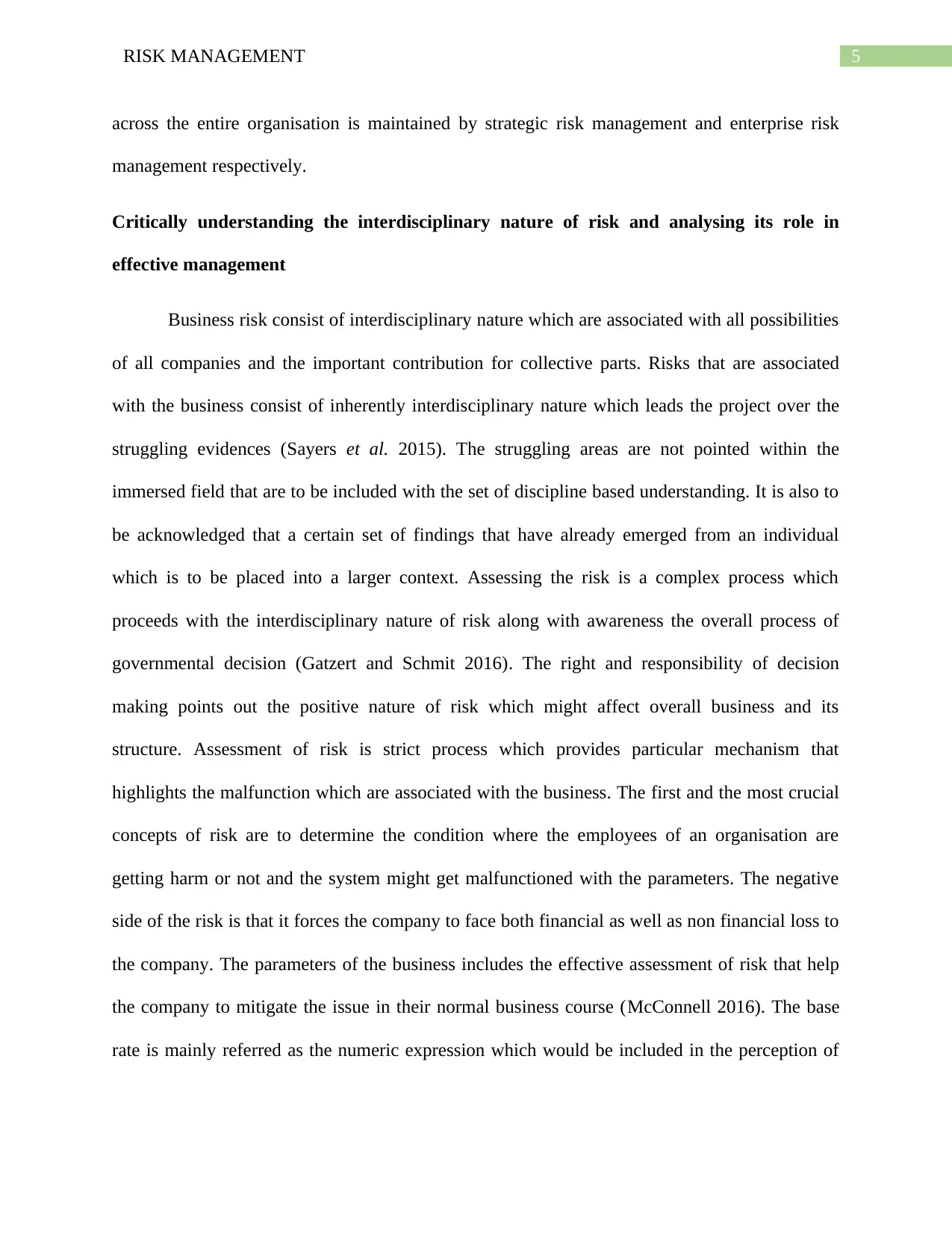
5RISK MANAGEMENT
across the entire organisation is maintained by strategic risk management and enterprise risk
management respectively.
Critically understanding the interdisciplinary nature of risk and analysing its role in
effective management
Business risk consist of interdisciplinary nature which are associated with all possibilities
of all companies and the important contribution for collective parts. Risks that are associated
with the business consist of inherently interdisciplinary nature which leads the project over the
struggling evidences (Sayers et al. 2015). The struggling areas are not pointed within the
immersed field that are to be included with the set of discipline based understanding. It is also to
be acknowledged that a certain set of findings that have already emerged from an individual
which is to be placed into a larger context. Assessing the risk is a complex process which
proceeds with the interdisciplinary nature of risk along with awareness the overall process of
governmental decision (Gatzert and Schmit 2016). The right and responsibility of decision
making points out the positive nature of risk which might affect overall business and its
structure. Assessment of risk is strict process which provides particular mechanism that
highlights the malfunction which are associated with the business. The first and the most crucial
concepts of risk are to determine the condition where the employees of an organisation are
getting harm or not and the system might get malfunctioned with the parameters. The negative
side of the risk is that it forces the company to face both financial as well as non financial loss to
the company. The parameters of the business includes the effective assessment of risk that help
the company to mitigate the issue in their normal business course (McConnell 2016). The base
rate is mainly referred as the numeric expression which would be included in the perception of
across the entire organisation is maintained by strategic risk management and enterprise risk
management respectively.
Critically understanding the interdisciplinary nature of risk and analysing its role in
effective management
Business risk consist of interdisciplinary nature which are associated with all possibilities
of all companies and the important contribution for collective parts. Risks that are associated
with the business consist of inherently interdisciplinary nature which leads the project over the
struggling evidences (Sayers et al. 2015). The struggling areas are not pointed within the
immersed field that are to be included with the set of discipline based understanding. It is also to
be acknowledged that a certain set of findings that have already emerged from an individual
which is to be placed into a larger context. Assessing the risk is a complex process which
proceeds with the interdisciplinary nature of risk along with awareness the overall process of
governmental decision (Gatzert and Schmit 2016). The right and responsibility of decision
making points out the positive nature of risk which might affect overall business and its
structure. Assessment of risk is strict process which provides particular mechanism that
highlights the malfunction which are associated with the business. The first and the most crucial
concepts of risk are to determine the condition where the employees of an organisation are
getting harm or not and the system might get malfunctioned with the parameters. The negative
side of the risk is that it forces the company to face both financial as well as non financial loss to
the company. The parameters of the business includes the effective assessment of risk that help
the company to mitigate the issue in their normal business course (McConnell 2016). The base
rate is mainly referred as the numeric expression which would be included in the perception of
⊘ This is a preview!⊘
Do you want full access?
Subscribe today to unlock all pages.

Trusted by 1+ million students worldwide
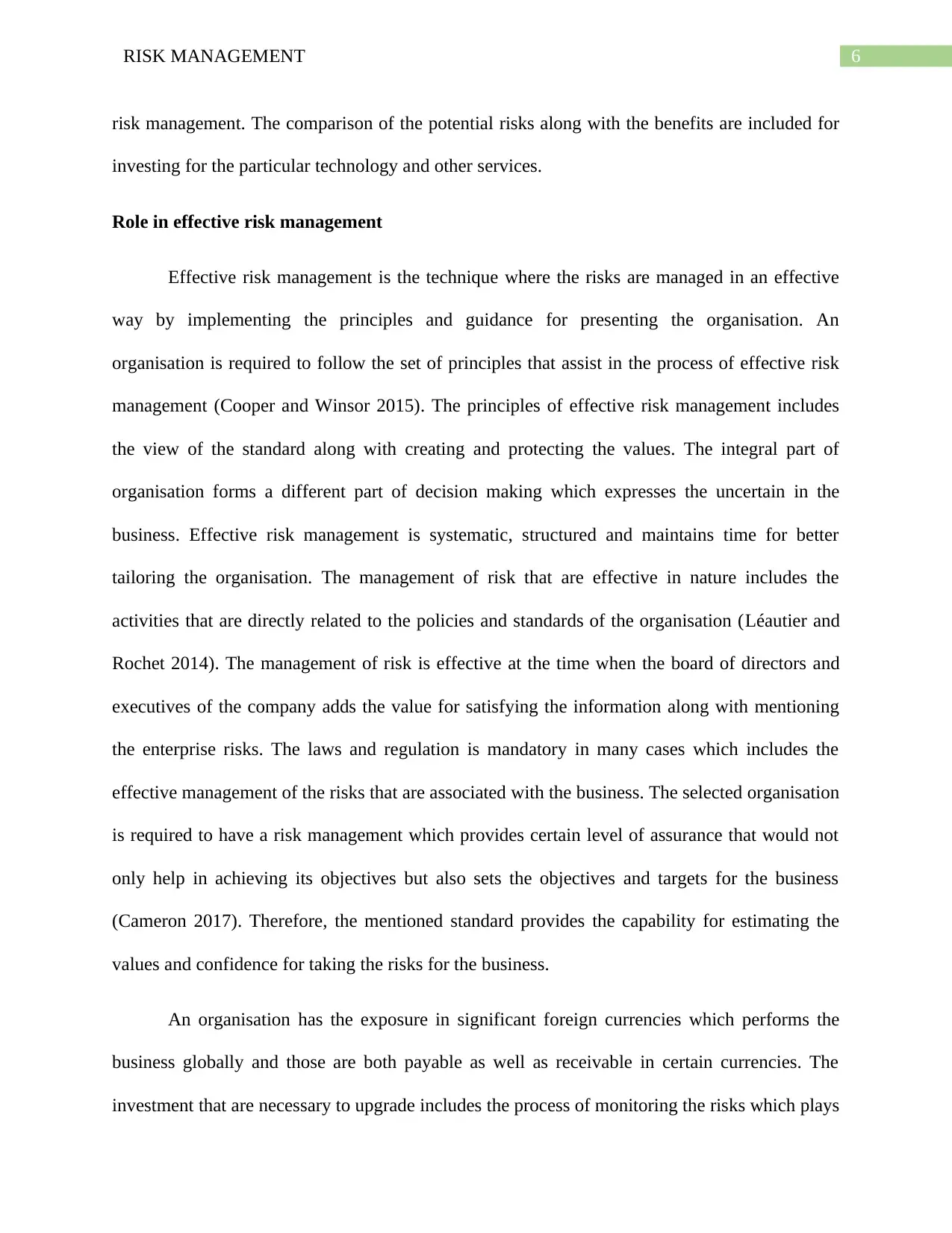
6RISK MANAGEMENT
risk management. The comparison of the potential risks along with the benefits are included for
investing for the particular technology and other services.
Role in effective risk management
Effective risk management is the technique where the risks are managed in an effective
way by implementing the principles and guidance for presenting the organisation. An
organisation is required to follow the set of principles that assist in the process of effective risk
management (Cooper and Winsor 2015). The principles of effective risk management includes
the view of the standard along with creating and protecting the values. The integral part of
organisation forms a different part of decision making which expresses the uncertain in the
business. Effective risk management is systematic, structured and maintains time for better
tailoring the organisation. The management of risk that are effective in nature includes the
activities that are directly related to the policies and standards of the organisation (Léautier and
Rochet 2014). The management of risk is effective at the time when the board of directors and
executives of the company adds the value for satisfying the information along with mentioning
the enterprise risks. The laws and regulation is mandatory in many cases which includes the
effective management of the risks that are associated with the business. The selected organisation
is required to have a risk management which provides certain level of assurance that would not
only help in achieving its objectives but also sets the objectives and targets for the business
(Cameron 2017). Therefore, the mentioned standard provides the capability for estimating the
values and confidence for taking the risks for the business.
An organisation has the exposure in significant foreign currencies which performs the
business globally and those are both payable as well as receivable in certain currencies. The
investment that are necessary to upgrade includes the process of monitoring the risks which plays
risk management. The comparison of the potential risks along with the benefits are included for
investing for the particular technology and other services.
Role in effective risk management
Effective risk management is the technique where the risks are managed in an effective
way by implementing the principles and guidance for presenting the organisation. An
organisation is required to follow the set of principles that assist in the process of effective risk
management (Cooper and Winsor 2015). The principles of effective risk management includes
the view of the standard along with creating and protecting the values. The integral part of
organisation forms a different part of decision making which expresses the uncertain in the
business. Effective risk management is systematic, structured and maintains time for better
tailoring the organisation. The management of risk that are effective in nature includes the
activities that are directly related to the policies and standards of the organisation (Léautier and
Rochet 2014). The management of risk is effective at the time when the board of directors and
executives of the company adds the value for satisfying the information along with mentioning
the enterprise risks. The laws and regulation is mandatory in many cases which includes the
effective management of the risks that are associated with the business. The selected organisation
is required to have a risk management which provides certain level of assurance that would not
only help in achieving its objectives but also sets the objectives and targets for the business
(Cameron 2017). Therefore, the mentioned standard provides the capability for estimating the
values and confidence for taking the risks for the business.
An organisation has the exposure in significant foreign currencies which performs the
business globally and those are both payable as well as receivable in certain currencies. The
investment that are necessary to upgrade includes the process of monitoring the risks which plays
Paraphrase This Document
Need a fresh take? Get an instant paraphrase of this document with our AI Paraphraser
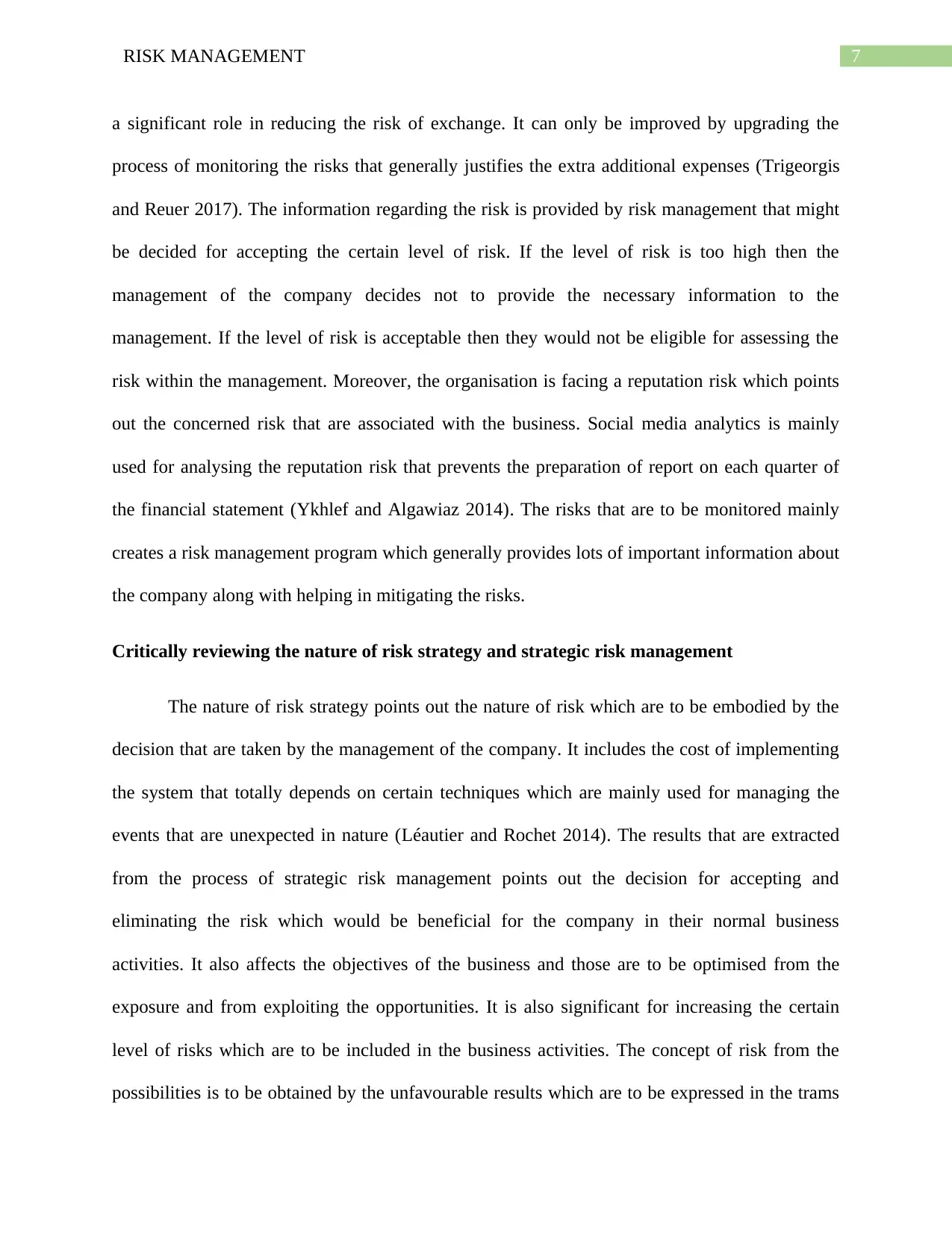
7RISK MANAGEMENT
a significant role in reducing the risk of exchange. It can only be improved by upgrading the
process of monitoring the risks that generally justifies the extra additional expenses (Trigeorgis
and Reuer 2017). The information regarding the risk is provided by risk management that might
be decided for accepting the certain level of risk. If the level of risk is too high then the
management of the company decides not to provide the necessary information to the
management. If the level of risk is acceptable then they would not be eligible for assessing the
risk within the management. Moreover, the organisation is facing a reputation risk which points
out the concerned risk that are associated with the business. Social media analytics is mainly
used for analysing the reputation risk that prevents the preparation of report on each quarter of
the financial statement (Ykhlef and Algawiaz 2014). The risks that are to be monitored mainly
creates a risk management program which generally provides lots of important information about
the company along with helping in mitigating the risks.
Critically reviewing the nature of risk strategy and strategic risk management
The nature of risk strategy points out the nature of risk which are to be embodied by the
decision that are taken by the management of the company. It includes the cost of implementing
the system that totally depends on certain techniques which are mainly used for managing the
events that are unexpected in nature (Léautier and Rochet 2014). The results that are extracted
from the process of strategic risk management points out the decision for accepting and
eliminating the risk which would be beneficial for the company in their normal business
activities. It also affects the objectives of the business and those are to be optimised from the
exposure and from exploiting the opportunities. It is also significant for increasing the certain
level of risks which are to be included in the business activities. The concept of risk from the
possibilities is to be obtained by the unfavourable results which are to be expressed in the trams
a significant role in reducing the risk of exchange. It can only be improved by upgrading the
process of monitoring the risks that generally justifies the extra additional expenses (Trigeorgis
and Reuer 2017). The information regarding the risk is provided by risk management that might
be decided for accepting the certain level of risk. If the level of risk is too high then the
management of the company decides not to provide the necessary information to the
management. If the level of risk is acceptable then they would not be eligible for assessing the
risk within the management. Moreover, the organisation is facing a reputation risk which points
out the concerned risk that are associated with the business. Social media analytics is mainly
used for analysing the reputation risk that prevents the preparation of report on each quarter of
the financial statement (Ykhlef and Algawiaz 2014). The risks that are to be monitored mainly
creates a risk management program which generally provides lots of important information about
the company along with helping in mitigating the risks.
Critically reviewing the nature of risk strategy and strategic risk management
The nature of risk strategy points out the nature of risk which are to be embodied by the
decision that are taken by the management of the company. It includes the cost of implementing
the system that totally depends on certain techniques which are mainly used for managing the
events that are unexpected in nature (Léautier and Rochet 2014). The results that are extracted
from the process of strategic risk management points out the decision for accepting and
eliminating the risk which would be beneficial for the company in their normal business
activities. It also affects the objectives of the business and those are to be optimised from the
exposure and from exploiting the opportunities. It is also significant for increasing the certain
level of risks which are to be included in the business activities. The concept of risk from the
possibilities is to be obtained by the unfavourable results which are to be expressed in the trams
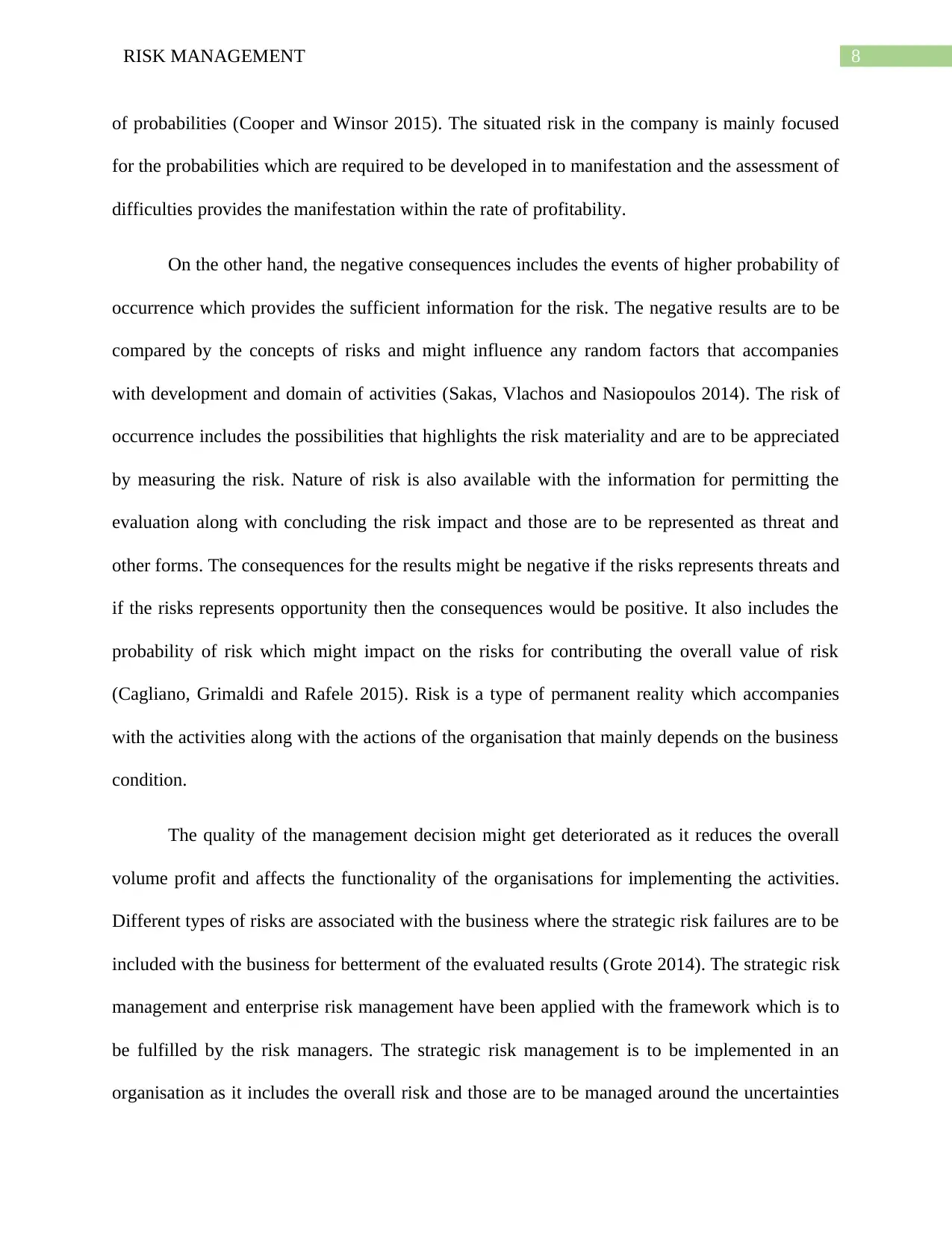
8RISK MANAGEMENT
of probabilities (Cooper and Winsor 2015). The situated risk in the company is mainly focused
for the probabilities which are required to be developed in to manifestation and the assessment of
difficulties provides the manifestation within the rate of profitability.
On the other hand, the negative consequences includes the events of higher probability of
occurrence which provides the sufficient information for the risk. The negative results are to be
compared by the concepts of risks and might influence any random factors that accompanies
with development and domain of activities (Sakas, Vlachos and Nasiopoulos 2014). The risk of
occurrence includes the possibilities that highlights the risk materiality and are to be appreciated
by measuring the risk. Nature of risk is also available with the information for permitting the
evaluation along with concluding the risk impact and those are to be represented as threat and
other forms. The consequences for the results might be negative if the risks represents threats and
if the risks represents opportunity then the consequences would be positive. It also includes the
probability of risk which might impact on the risks for contributing the overall value of risk
(Cagliano, Grimaldi and Rafele 2015). Risk is a type of permanent reality which accompanies
with the activities along with the actions of the organisation that mainly depends on the business
condition.
The quality of the management decision might get deteriorated as it reduces the overall
volume profit and affects the functionality of the organisations for implementing the activities.
Different types of risks are associated with the business where the strategic risk failures are to be
included with the business for betterment of the evaluated results (Grote 2014). The strategic risk
management and enterprise risk management have been applied with the framework which is to
be fulfilled by the risk managers. The strategic risk management is to be implemented in an
organisation as it includes the overall risk and those are to be managed around the uncertainties
of probabilities (Cooper and Winsor 2015). The situated risk in the company is mainly focused
for the probabilities which are required to be developed in to manifestation and the assessment of
difficulties provides the manifestation within the rate of profitability.
On the other hand, the negative consequences includes the events of higher probability of
occurrence which provides the sufficient information for the risk. The negative results are to be
compared by the concepts of risks and might influence any random factors that accompanies
with development and domain of activities (Sakas, Vlachos and Nasiopoulos 2014). The risk of
occurrence includes the possibilities that highlights the risk materiality and are to be appreciated
by measuring the risk. Nature of risk is also available with the information for permitting the
evaluation along with concluding the risk impact and those are to be represented as threat and
other forms. The consequences for the results might be negative if the risks represents threats and
if the risks represents opportunity then the consequences would be positive. It also includes the
probability of risk which might impact on the risks for contributing the overall value of risk
(Cagliano, Grimaldi and Rafele 2015). Risk is a type of permanent reality which accompanies
with the activities along with the actions of the organisation that mainly depends on the business
condition.
The quality of the management decision might get deteriorated as it reduces the overall
volume profit and affects the functionality of the organisations for implementing the activities.
Different types of risks are associated with the business where the strategic risk failures are to be
included with the business for betterment of the evaluated results (Grote 2014). The strategic risk
management and enterprise risk management have been applied with the framework which is to
be fulfilled by the risk managers. The strategic risk management is to be implemented in an
organisation as it includes the overall risk and those are to be managed around the uncertainties
⊘ This is a preview!⊘
Do you want full access?
Subscribe today to unlock all pages.

Trusted by 1+ million students worldwide
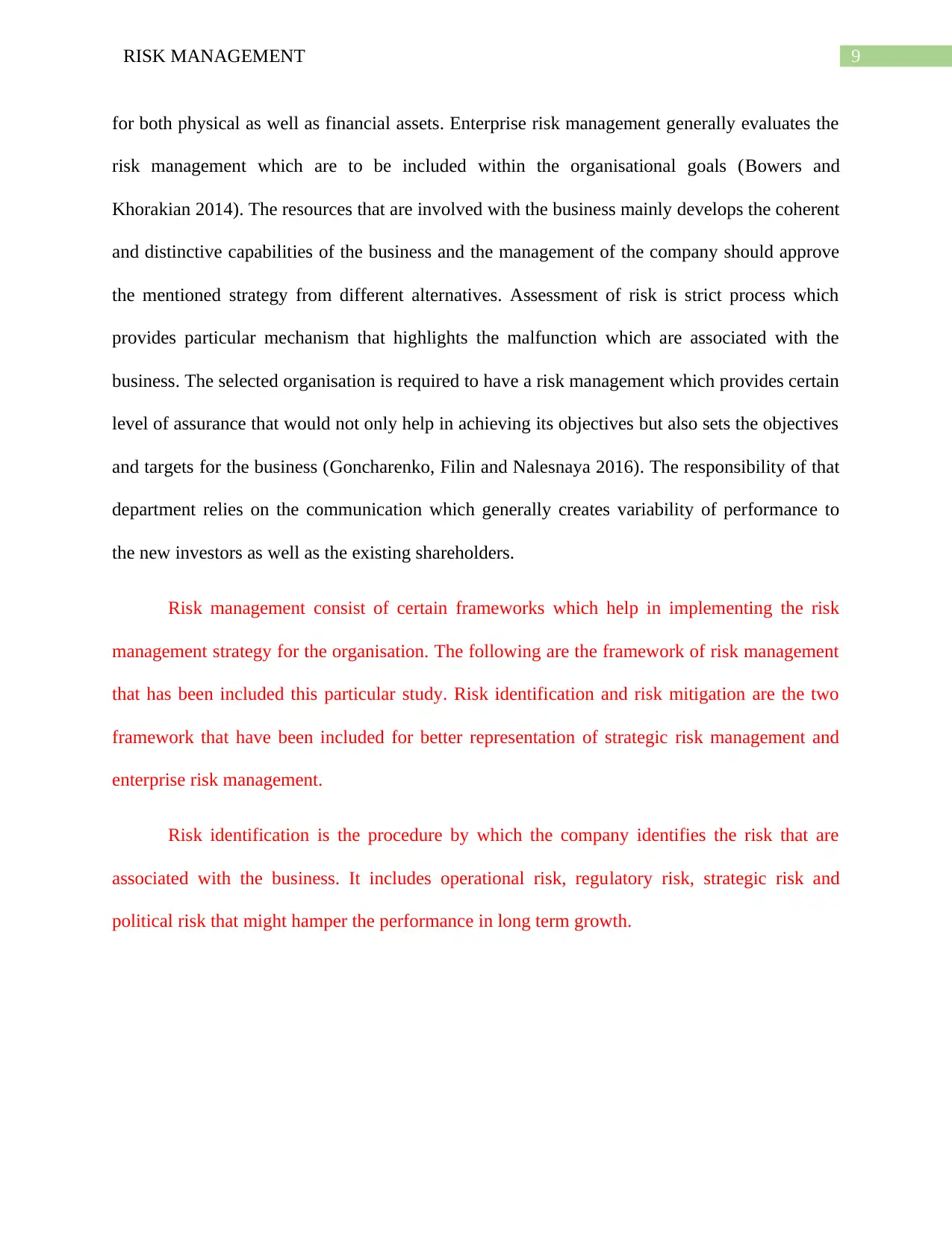
9RISK MANAGEMENT
for both physical as well as financial assets. Enterprise risk management generally evaluates the
risk management which are to be included within the organisational goals (Bowers and
Khorakian 2014). The resources that are involved with the business mainly develops the coherent
and distinctive capabilities of the business and the management of the company should approve
the mentioned strategy from different alternatives. Assessment of risk is strict process which
provides particular mechanism that highlights the malfunction which are associated with the
business. The selected organisation is required to have a risk management which provides certain
level of assurance that would not only help in achieving its objectives but also sets the objectives
and targets for the business (Goncharenko, Filin and Nalesnaya 2016). The responsibility of that
department relies on the communication which generally creates variability of performance to
the new investors as well as the existing shareholders.
Risk management consist of certain frameworks which help in implementing the risk
management strategy for the organisation. The following are the framework of risk management
that has been included this particular study. Risk identification and risk mitigation are the two
framework that have been included for better representation of strategic risk management and
enterprise risk management.
Risk identification is the procedure by which the company identifies the risk that are
associated with the business. It includes operational risk, regulatory risk, strategic risk and
political risk that might hamper the performance in long term growth.
for both physical as well as financial assets. Enterprise risk management generally evaluates the
risk management which are to be included within the organisational goals (Bowers and
Khorakian 2014). The resources that are involved with the business mainly develops the coherent
and distinctive capabilities of the business and the management of the company should approve
the mentioned strategy from different alternatives. Assessment of risk is strict process which
provides particular mechanism that highlights the malfunction which are associated with the
business. The selected organisation is required to have a risk management which provides certain
level of assurance that would not only help in achieving its objectives but also sets the objectives
and targets for the business (Goncharenko, Filin and Nalesnaya 2016). The responsibility of that
department relies on the communication which generally creates variability of performance to
the new investors as well as the existing shareholders.
Risk management consist of certain frameworks which help in implementing the risk
management strategy for the organisation. The following are the framework of risk management
that has been included this particular study. Risk identification and risk mitigation are the two
framework that have been included for better representation of strategic risk management and
enterprise risk management.
Risk identification is the procedure by which the company identifies the risk that are
associated with the business. It includes operational risk, regulatory risk, strategic risk and
political risk that might hamper the performance in long term growth.
Paraphrase This Document
Need a fresh take? Get an instant paraphrase of this document with our AI Paraphraser
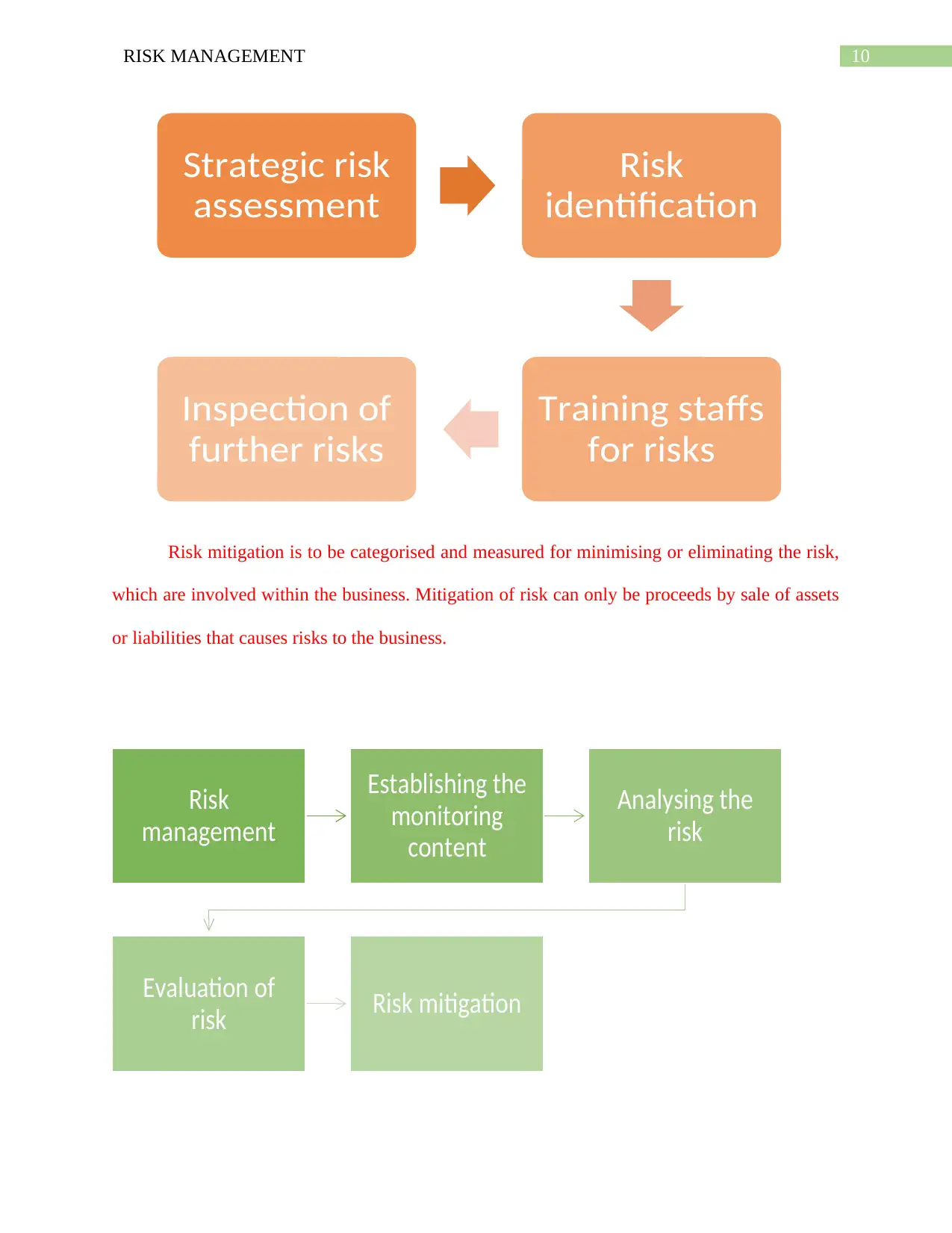
10RISK MANAGEMENT
Risk mitigation is to be categorised and measured for minimising or eliminating the risk,
which are involved within the business. Mitigation of risk can only be proceeds by sale of assets
or liabilities that causes risks to the business.
Strategic risk
assessment
Risk
identification
Training staffs
for risks
Inspection of
further risks
Risk
management
Establishing the
monitoring
content
Analysing the
risk
Evaluation of
risk Risk mitigation
Risk mitigation is to be categorised and measured for minimising or eliminating the risk,
which are involved within the business. Mitigation of risk can only be proceeds by sale of assets
or liabilities that causes risks to the business.
Strategic risk
assessment
Risk
identification
Training staffs
for risks
Inspection of
further risks
Risk
management
Establishing the
monitoring
content
Analysing the
risk
Evaluation of
risk Risk mitigation
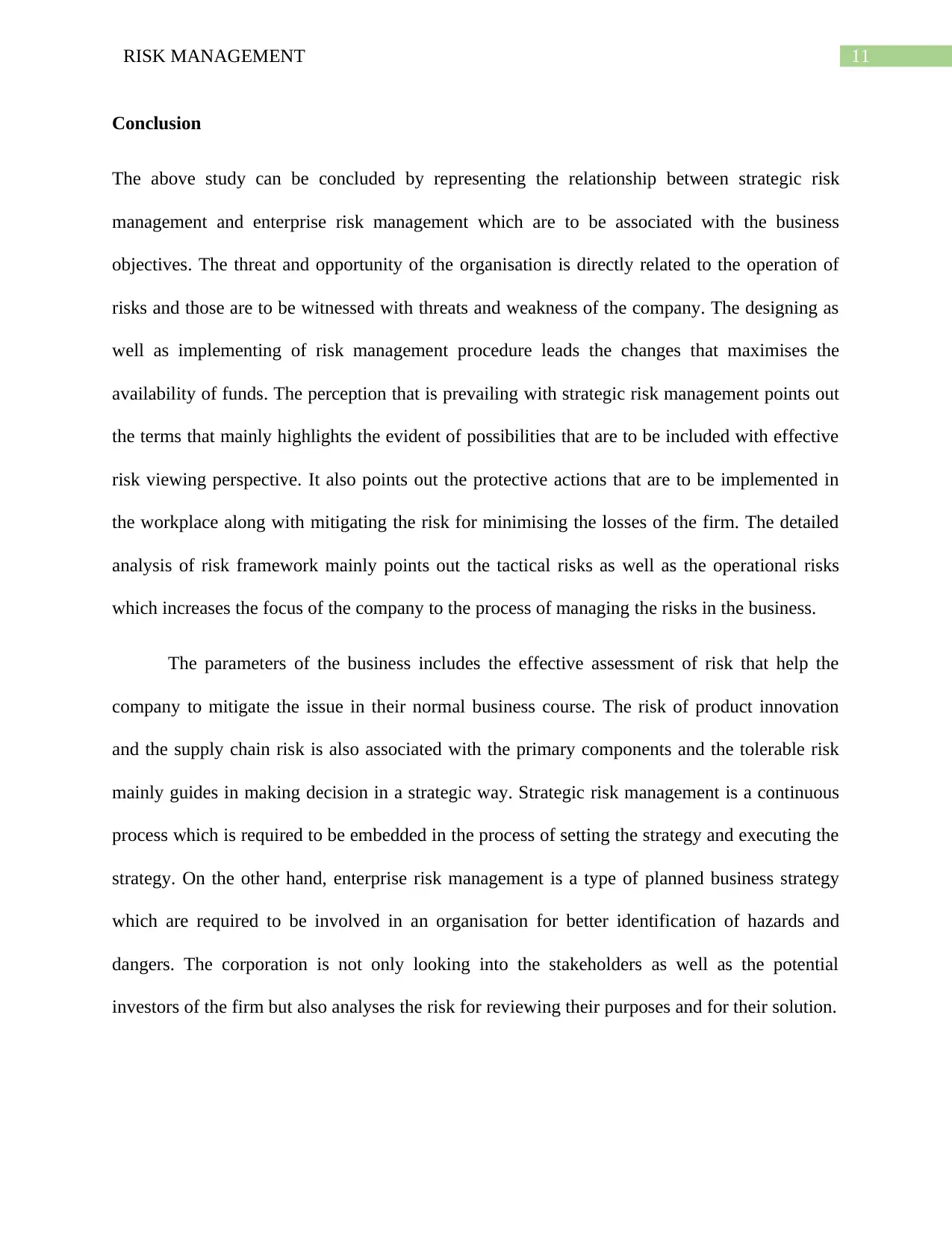
11RISK MANAGEMENT
Conclusion
The above study can be concluded by representing the relationship between strategic risk
management and enterprise risk management which are to be associated with the business
objectives. The threat and opportunity of the organisation is directly related to the operation of
risks and those are to be witnessed with threats and weakness of the company. The designing as
well as implementing of risk management procedure leads the changes that maximises the
availability of funds. The perception that is prevailing with strategic risk management points out
the terms that mainly highlights the evident of possibilities that are to be included with effective
risk viewing perspective. It also points out the protective actions that are to be implemented in
the workplace along with mitigating the risk for minimising the losses of the firm. The detailed
analysis of risk framework mainly points out the tactical risks as well as the operational risks
which increases the focus of the company to the process of managing the risks in the business.
The parameters of the business includes the effective assessment of risk that help the
company to mitigate the issue in their normal business course. The risk of product innovation
and the supply chain risk is also associated with the primary components and the tolerable risk
mainly guides in making decision in a strategic way. Strategic risk management is a continuous
process which is required to be embedded in the process of setting the strategy and executing the
strategy. On the other hand, enterprise risk management is a type of planned business strategy
which are required to be involved in an organisation for better identification of hazards and
dangers. The corporation is not only looking into the stakeholders as well as the potential
investors of the firm but also analyses the risk for reviewing their purposes and for their solution.
Conclusion
The above study can be concluded by representing the relationship between strategic risk
management and enterprise risk management which are to be associated with the business
objectives. The threat and opportunity of the organisation is directly related to the operation of
risks and those are to be witnessed with threats and weakness of the company. The designing as
well as implementing of risk management procedure leads the changes that maximises the
availability of funds. The perception that is prevailing with strategic risk management points out
the terms that mainly highlights the evident of possibilities that are to be included with effective
risk viewing perspective. It also points out the protective actions that are to be implemented in
the workplace along with mitigating the risk for minimising the losses of the firm. The detailed
analysis of risk framework mainly points out the tactical risks as well as the operational risks
which increases the focus of the company to the process of managing the risks in the business.
The parameters of the business includes the effective assessment of risk that help the
company to mitigate the issue in their normal business course. The risk of product innovation
and the supply chain risk is also associated with the primary components and the tolerable risk
mainly guides in making decision in a strategic way. Strategic risk management is a continuous
process which is required to be embedded in the process of setting the strategy and executing the
strategy. On the other hand, enterprise risk management is a type of planned business strategy
which are required to be involved in an organisation for better identification of hazards and
dangers. The corporation is not only looking into the stakeholders as well as the potential
investors of the firm but also analyses the risk for reviewing their purposes and for their solution.
⊘ This is a preview!⊘
Do you want full access?
Subscribe today to unlock all pages.

Trusted by 1+ million students worldwide
1 out of 15
Related Documents
Your All-in-One AI-Powered Toolkit for Academic Success.
+13062052269
info@desklib.com
Available 24*7 on WhatsApp / Email
![[object Object]](/_next/static/media/star-bottom.7253800d.svg)
Unlock your academic potential
Copyright © 2020–2025 A2Z Services. All Rights Reserved. Developed and managed by ZUCOL.





